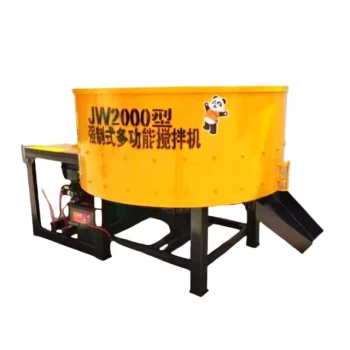Choosing the right concrete mix involves balancing strength, workability, and project requirements. The mix must meet the structural demands (measured in PSI), suit the construction environment, and align with logistical factors like mixing capacity and material handling. Key considerations include project scale, PSI requirements, mixer type, and consistency monitoring during mixing. Proper planning ensures durability, cost-efficiency, and safety.
Key Points Explained:
-
Understand PSI Requirements
- PSI (pounds per square inch) defines concrete strength. Standard projects use 2500–5500 PSI, while high-strength applications (e.g., bridges) require 6000+ PSI.
- Example: A driveway might need 3000 PSI, whereas a high-rise foundation demands 5000+ PSI.
-
Assess Project Scale and Logistics
- Small projects (e.g., patios): Portable concrete mixers or batch mixers suffice.
- Large projects (e.g., commercial slabs): Continuous or stationary mixers ensure consistent volume.
- Logistics: Distance from batching plants and hourly delivery needs impact mixer choice.
-
Monitor Mix Consistency
- Ideal mix rises halfway up the drum and falls back.
- Too dry: Mixture touches drum top (add water).
- Too wet: Doesn’t rise (add dry materials).
- Ever wondered how consistency affects curing? Proper hydration ensures strength development.
- Ideal mix rises halfway up the drum and falls back.
-
Optimize Mixer Selection
- Mobility: Wheelbarrow mixers for tight spaces; truck-mounted for large sites.
- Durability: Stainless steel drums resist wear in abrasive mixes.
- Pro Tip: For colored/stamped concrete, choose mixers with precise speed control.
-
Plan for Safety and Efficiency
- Location: Stable, level ground prevents spills.
- Storage: Keep cement dry to avoid clumping.
- Training: Workers must understand operation and emergency protocols.
-
Cost vs. Quality Trade-offs
- High-PSI mixes cost more but reduce long-term repairs.
- Renting vs. buying mixers depends on project frequency.
Final Thought: Like baking a cake, the right "recipe" (mix design) and "oven" (mixer) determine the outcome. Prioritize structural needs, then tailor equipment and workflow to match. After all, concrete isn’t just a material—it’s the backbone of modern infrastructure.
Summary Table:
| Factor | Key Consideration |
|---|---|
| PSI Requirements | Standard projects: 2500–5500 PSI; high-strength (e.g., bridges): 6000+ PSI. |
| Project Scale | Small projects: portable mixers; large projects: continuous/stationary mixers. |
| Mix Consistency | Ideal mix rises halfway up the drum. Adjust water/dry materials if too dry/wet. |
| Mixer Selection | Mobility (wheelbarrow/truck-mounted), durability (stainless steel), speed control. |
| Safety & Efficiency | Stable ground, dry cement storage, and trained workers ensure smooth operations. |
| Cost vs. Quality | High-PSI mixes cost more but reduce repairs; rent/buy mixers based on project needs. |
Need reliable equipment for your concrete project? Contact us to explore Garlway’s durable winches and construction machinery for seamless mixing and handling!
Related Products
- Ready Mixer Machine for Construction Ready Mix Machinery
- Commercial Construction Mixer Machine for Soil Cement Mixing Concrete
- Auto Concrete Cement Mixer Machine New
- HZS90 Large Multiquip Concrete Mixers for Construction
- JDC350 Small Cement Concrete Mortar Mixer
People Also Ask
- Can a concrete mixer be used for mortar? Key Considerations for Optimal Mixing
- How does concrete not harden in a truck? The Science Behind Workable Concrete
- How do you maintain a concrete mixer? Essential Tips for Longevity & Performance
- What are the 4 classifications of concrete mix? Essential Guide for Construction Pros
- Is there a difference between a concrete mixer and a mortar mixer? Key Differences Explained



















